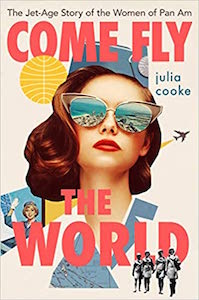In the photo on the cover of the February 1969 special issue of Wing Tips, three women show off new uniform options as they admire a model 747. Two wear the skirt-and-jacket outfit and one wears the knee-length overcoat with its exaggeratedly pointed collar. Around each woman’s face, bobbed hair curls gently. One of the women is blond, another is of indeterminate Asian descent, and the third is African-American.
Diversity among its stewardesses had been a company goal for years, although within very limited parameters. A range of smiling, eager-to-please women of varying backgrounds and from various cultures could reinforce the image of a global airline. In 1955 Pan Am began to hire dozens of Japanese-American women based in Honolulu, its “Nisei stewardesses,” ostensibly because they could speak Japanese on Pacific routes. In reality, few of them spoke Japanese fluently. Still, the women projected a corporate ideal—Najeeb Halaby hoped that all stewardesses might be “more like Japanese geisha girls, prepared to flatter and entertain the male passengers.” For the stewardesses themselves, largely the children of recent immigrants raised in rural Hawaii, travel presented both mobility and an opportunity to acquire the polish of upper-class America.
Such perceived exoticism did not apply to African-American women on Pan Am or any other airline. Black women attended the stewardess schools of the 1950s and early 1960s, unaffiliated training courses that promised to prepare aspiring stewardesses for successful interviews. These women watched as their white peers received offers from the small airlines that visited the schools while their own letters never arrived. Airline executives openly admitted that they feared losing their market share if the women who served mostly white passengers were Black. They were also concerned, as one New York Times article explained, that “existing and potential ranks of white stewardesses would dwindle fast if the ‘glamor’ of the job were ‘down-graded’ by the employment of Negro girls.”
Lawyers with the NAACP and the Urban League built cases on behalf of the Black women graduating from stewardess schools with qualifications that should have guaranteed them jobs in flight service—they were educated, elegant, extroverted, and well within height and weight specifications. The lawsuits were widely covered in the American Black media. In the Soviet media, too, newspapers gleefully covered this visible iteration of capitalist racism. “Last year the State Department . . . was obliged to acknowledge that Pravda told the truth when it declared that bigotry barred negro girls from one of the most coveted careers open to women in this country,” read a 1958 article in the NAACP’s national magazine.
Airline executives openly admitted that they feared losing their market share if the women who served mostly white passengers were Black.As lawsuits unfolded in courtrooms around the country, details about the extent of the racial bias against African-American women were splashed across newspapers nationwide. One applicant testified to her measurements on the stand: thirty-three, twenty-two, thirty-six, the feminine ideal. Another had been assessed as “too masculine” and having “an arrogant attitude,” and in an especially acrobatic line of argument, the fact that she had brought a lawsuit at all was “evidence of an antagonistic attitude . . . such an attitude would constitute a lack of competence to deal with passengers on the airline.”
Woman by woman, the aspiring stewardesses won their cases. In 1962 one of the first plaintiffs smiled from the cover of Jet magazine in a Northwest Airlines uniform. “Open Skies for Negro Girls,” read a 1963 Ebony headline. The Black newspaper the Chicago Defender praised American Airlines for promoting its first Black stewardess to supervisor; the Southern Christian Leadership Conference organized a boycott against Delta, whose numbers of Black employees remained low. In 1965, about fifty African-American women worked as stewardesses across all airlines.
By the time the 747 launch approached, nearly one thousand Black stewardesses worked across all airlines. Pan Am would soon employ about one hundred Black women, and though the airline hoped to hire more, recruitment efforts stalled, possibly due to recruiters’ biases, the pressure on aspiring stewardesses to conform to white beauty standards, the savings required to float through training and the low-paying first few months of the job, or all of the above. In June 1969, the Pan Am employee newsletter, the Clipper, ran a feature profile of twin pursers from Philadelphia that made nothing of their race but highlighted the superb qualifications of the “vivacious twin girls,” their identical faces, and their enthusiasm for the job. “You either enjoy dealing with people or you don’t. And if you don’t, you are not good stewardess material,” said Elaine Vaughn. “There are so many places to see, so many people to meet. And we’re really anxious to try the 747.” The women appreciated the access they had to places and people, to European fashions before they hit the United States, to bargains—one of the twins had seen Funny Girl in Portugal for seventy-five cents—and to other similar-minded women. Even as Black stewardesses talked among themselves about the occasional vaguely racist comment at training school, many recognized in their fellow Pan Am stewardesses a genuine interest in people, in other cultures, in thinking outside their own circumstances.
To college senior Hazel Bowie, any airline would do. At seventeen, she had already looked up the minimum age requirement for a stewardess job. The man from the Urban League handed her applications from three airlines that were actively seeking qualified African-American crew: Northwest, TWA, and Pan Am. Hazel’s only criterion was that the job get her as far from lakes, cornfields, and snowdrifts as possible. Hazel had not been able to afford tuition at a historically Black college like Howard or Spelman. When Hazel graduated from high school, her mother wanted her to attend college classes at a school near their St. Paul, Minnesota, home. That way Hazel could save rent money and continue to help around the house and look after her four younger siblings. Besides, Hazel’s mother could more easily keep an eye on her if she lived at home. “You have no fear,” her mother used to warn her.
Hazel—stylish, quick, and not fearless but close to it—had moved out. Mankato State College, the rapidly growing institution that would soon become the state’s second research university, was only eighty miles south but that was far enough to make living at home impractical. She could not stay home and take care of her siblings, work to pay for college, and study on top of it all, she told her mother. Better to live at school and work all the harder at odd jobs.
When Hazel flung her arms around her mother’s shoulders and rested her head against her cheek, they looked almost like the same person, years apart. They had the same bright, light brown skin, the same high cheekbones, although Hazel’s almond-shaped eyes and thin eyebrows were all her own. Hazel loved her mother, but she wanted to graduate in four years. She could not do it while living at home.
Hazel’s answer to the unfamiliar, to challenge, had always been the same. When a Mexican girl at the all-white suburban middle school to which Hazel had been bused from downtown St. Paul invited her over to learn to make tacos, Hazel said yes. High-school jobs addressing letters for administrators and reading to blind students? Yes. Weekend gig at the telephone company singing, “Op-e-ray-tor, how may I help you?” into the line over and over again? Yes. Strut down a catwalk in the church basement for a fashion-show fundraiser? Yes. Work as a coat-check girl in college, then back to the telephone company in St. Paul? Yes and yes. She learned that she liked being around people; she learned that she did not like working in an office. Hazel always wanted more, always said yes.
In 1968, someone invited her to join an all-night drive from Mankato to Washington, DC, to participate in the Solidarity Day march on June 19—Juneteenth—and Hazel said yes. Earlier, Dr. Martin Luther King had announced the Poor People’s Campaign as a “middle ground between riots on the one hand and timid supplications for justice on the other.” Here Hazel’s mother drew the line. After Dr. King’s murder in April, protests had broken out in Washington, DC, Detroit, Tallahassee, Denver, Oakland, and New York. Some exploded into riots. Thirty-nine Americans were dead, twenty-one thousand had been arrested, and twenty-six hundred were injured. In Washington in April, the violence had begun as a peaceful march but detonated with a rock thrown into a store window, a trash can tossed into the air, lighter fluid sparking a blaze in a tree. The police had shot and killed two Americans, including a fifteen-year-old boy. Nine hundred businesses were ruined, thirteen Americans dead, seventy-six hundred people arrested, and seven hundred residences destroyed. Thirteen thousand troops rolled into the city to impose a strained silence, arresting mostly Black citizens on the streets after a four pm curfew. Buildings of brick and stone lay crumbled on the ground. Hazel’s mother was not about to allow her own flesh and blood to get anywhere near such violence.
“I’m not asking your permission,” Hazel had told her mother. “I’m just letting you know I’m going.”
That trip was Hazel’s first real time in a state other than Minnesota, where she lived, and Mississippi, where she was born. At the march she listened to Coretta Scott King speaking to a crowd of around a hundred thousand Americans about how racism, poverty, and war worked together to, as she said, “deepen the hatred, heighten the bitterness, increase the frustration, and further alienate the poor in our society.” Looking at the crowd around her—people filling the National Mall, wading in the Reflecting Pool, and standing on risers high above—Hazel saw, for the first time on an enormous scale, an inversion of the racial proportions with which she lived. The only other places where Hazel had been among a majority of Black people had been in the offices of the Urban League in downtown St. Paul and on her family’s farm in Lena, Mississippi.
Lena had always made Hazel uncomfortable. Her family moved away when she was six, her parents heading north along with millions of other Black Americans. They visited the farm every year, marathon drives made almost without stopping. When Hazel was around eight or so, her mother had rushed, wild-eyed, toward her and her brother as they left a restroom during a rare late-night pause at a gas station. “You know you’re not supposed to be in there,” her mother had said fearfully. Hazel was confused. Her mother pointed at the sign: whites only. Hazel had never seen a sign like that before. “How am I supposed to know that?” she asked. “We don’t have that where we live.”
“And that’s why we live there instead of here,” her mother said. “Now get back in the car.” As they drove on, she explained to Hazel that this was why she and Hazel’s father swapped turns at the wheel rather than stopping at a hotel in a town on the way. This was why they brought food and ate in the car instead of going to a restaurant. Not every establishment along the road would serve the Bowie family, and their physical safety was not guaranteed if they accidentally stopped in the wrong place. In the last edition of the Negro Motorist Green Book, which was published as Hazel finished high school in the late sixties, Memphis had two dozen Black-owned cafés, gas stations, and hotels that could be counted on to serve her family. But there were few such establishments outside of cities. The entry on Mississippi listed only three dozen safe stops across the state. And entire towns could pose an ever-spiraling threat to a Black family who stopped there after dark. Hundreds of signs using a particular racial slur warned Black travelers not to let the sun go down on them in whatever town they were passing through, and these so-called sundown towns stretched across Iowa, Missouri, Illinois, and all the states between Minnesota and Mississippi. Over years of family visits up and down the interstate, Hazel watched her mother and father drive, exhausted, over endless stretches of dark highway. Never in her life would Hazel find a way to express what she’d felt as a child in that gas station in the dark somewhere between St. Paul and Lena, looking at her mother’s frightened face.
In Mankato, amid the flat farmland pocked by thousands of glassy lakes, Hazel signed up for every class on European history, literature, and art. Windy winters weighted the tree branches with heavy snow and piled the sides of streets with drifts almost as tall as Hazel. She read about the Continent, imagining cobblestoned streets carved through cities built long before the founding of the United States, frescoes in churches painted centuries before anyone had erected a steeple in her state. A Midwest high-school education had steeped her in American history, but Hazel wanted more, further back, farther away.
In her final year of college at Mankato State, Hazel did not care what sort of work got her out of town. But she had not forgotten her earlier dream of becoming a stewardess. She knew a girl in her neighborhood whose older sister worked on Northwest’s airplanes. She took the applications, filled in her information, and waited for her interviews.
Her mother made no secret of her nervousness. She thought Hazel could use more fear. She should stay in St. Paul— if not at home, at least safe in her own city. “You got your degree, you’ve got to stay and do something for the neighborhood,” her mother said.
“She’s not doing anything for the community until she does something for herself,” the people at church told her mother.
“She’s always gotten into too much right here in Minnesota,” her mother countered. How could Hazel keep herself safe everywhere else? Hazel did not know. Contrary to what her mother thought, fear did hide somewhere inside her, but Hazel, as long as she was not alone, as long as she was accompanied, would go anywhere. She had never met the women on the covers of Jet and Ebony, but she knew they existed. She knew she would not be alone.
_____________________________________________
My goal, in writing Come Fly the World, was to place the story of the intersectional, boundary-breaking women of Pan Am within the broader context of the Jet Age and the many changes of the era. In addition to interviews with Hazel and other women, I consulted resources that tell a more comprehensive story of the integration of the airlines in the voices of the pioneering women who forged these changes. There are relatively few first-person accounts of the experiences of Black stewardesses during this era, but those that are out there are wonderful and deserve many more eyes and ears. A group of former Pan Am stewardesses who call themselves the “Blackbirds” have told their stories on the radio, in articles, and on educational panels. And 35-year Delta flight attendant Casey Grant’s Stars in the Sky tells the story of the Black pioneers in aviation through both her own personal experience and the anecdotes of others, bolstered, in both cases, by thorough research. I want to acknowledge the debt I owe to these remarkable women’s first-hand accounts, and encourage others to follow their work as well.
_____________________________________________

Excerpted from Come Fly the World by Julia Cooke. Copyright © 2021 by Julia Cooke. Published and reprinted by permission of Houghton Mifflin Harcourt. All rights reserved.


